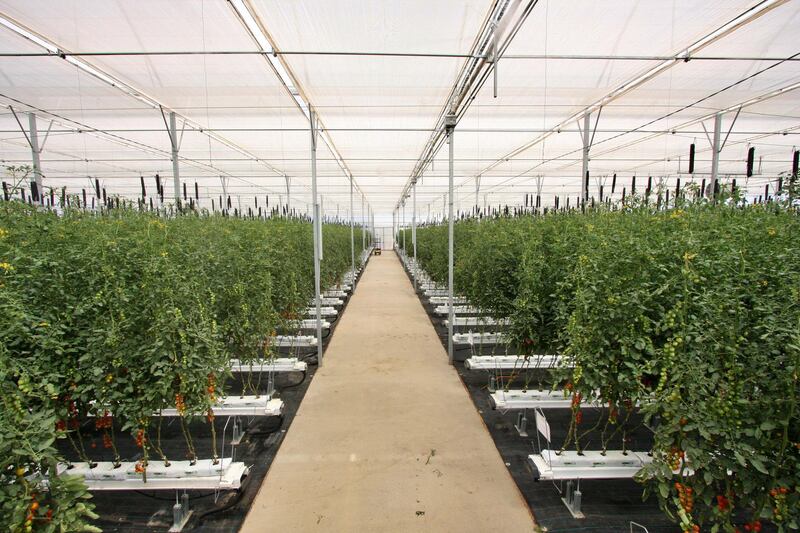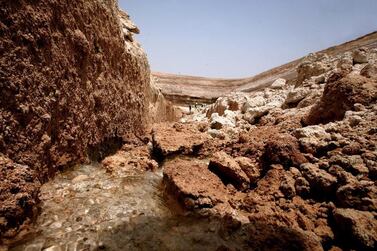When Rania Al Ofair's husband was sent to prison for unpaid debts two years ago, her only experience of running the family farm that provided their income was watching him work while she drank coffee.
Now, in the desert town of Azraq in north-east of Jordan – a 90-minute drive east of Amman – Al Ofair, 45, is not only ensuring the farm survives, she is single-handedly building a business that thrives, thanks in part to soil-less farming technology.
It's a hot afternoon when The National meets the beaming mother-of-five as she leads the way, shaded by trees, to a small hut that was built using green mesh material tied to a metal frame. A layer of pebbles lines the floor and a protective plastic sheeting covers the roof, with the option to drop other pieces down on the sides. Inside are shelving units holding white tubs that contain sprouting barley. It is these green shoots that paved the way to Al Ofair's success.
How hydroponic farming is revolutionising rural Jordan
As one of 20 participants in the World Food Programme's H2Grow initiative in February, Al Ofair was trained in how to use hydroponic farming to grow fodder for farm animals, which means growing crops without using soil. She has shown her local community what can be achieved. "I recently made it into the local paper because of this project," she says. "I applied for a loan through the community to buy new equipment, so they wanted to know what the project was and why I needed the money. I showed them, they took a photo and then there was an article about me."
She says she often shows people around the farm and explains how easy it is for others to emulate the technique.
At its most complex level, hydroponic farming can involve controllable variables such as carbon dioxide, air temperature, humidity, oxygen and hydrogen levels, electrical conductivity and root-zone temperature. Mineral consumption, energy and water can also be monitored.
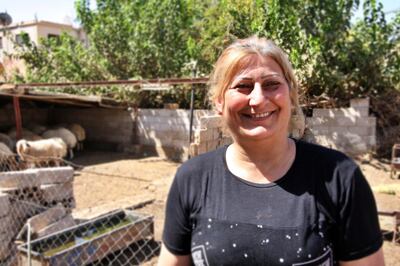
Having this level of control allows farmers to grow crops all year round. However, Al Ofair uses the most simple form of hydroponic farming – the seeds are protected from sunlight and dirt and are simply sprayed with water, generating green fodder within a few days.
"Rather than feeding my animals dry grains, they now have green fodder every day," she says. "It's greatly improved the quality and the quantity of the milk – the sheep were each providing less than half a kilo of milk per day but now I get 1.5 kilos per day. The quality of the meat is better and so is the quality of the wool, so I'm able to charge more."
Why more people should try the technique
Al Ofair has also learnt how to take care of the animals. She has got a taste of the business world and is determined to find other ways to increase her profit. "My husband used to be worried about leaving the animals, so he thinks what I'm doing is amazing," she says. "He keeps encouraging me and wants to expand the business when he gets out of prison."
The WFP has also launched a more high-tech unit in the same area that offers much greater control and produces a larger amount of the fodder. The enclosed unit, which is run by a team of Syrians and Jordanians, isolates the crops from outside elements, insects and disease. The crops are sold in the community.
The WFP's H2Grow began in refugee camps in the Algerian province of Tindouf and has since been introduced across seven countries. The technology reduces costs by between 15 and 50 per cent compared to traditional farming techniques, while requiring 80 per cent less space and using 90 per cent less water. That is critical in Jordan, which is among the 10 most water-scarce countries in the world.
The WFP programme's policy officer Lama Almajali, who heads the initiative, says the technology helps to tackle environmental problems, water scarcity and food insecurity. Azraq was selected for the H2Grow initiative because it is an area of Jordan where farmers struggle to provide their animals with enough nutritional fodder.
"We noticed a lot of NGOs were doing hydroponics in Jordan but we wanted to become advocates for this," she says. "We tried to help other organisations learn from our experience instead of starting from scratch. We have manuals, we can save them time, effort and money. This is where the hydroponics platform came from."
Why water preservation is crucial in Jordan
Companies such as ECO Consult worked with the WFP to deliver the project. ECO is a local company that works with leading Jordanian farmers to introduce hydroponic technology on a large scale, thanks to funding from the Netherlands and the United States Agency for International Development. "If you produce about 25 kilograms of tomatoes per square metre in an ordinary greenhouse, using the top level of hydroponics you could increase that to about 75 kilograms," says ECO Consult chief executive Raed Daoud.
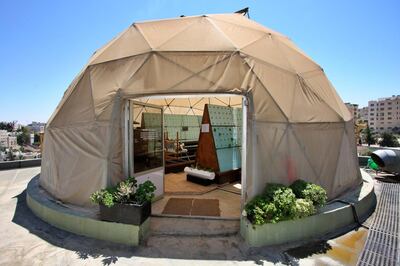
He stresses the need to find ways to preserve water. "In Jordan, for every kilo of tomatoes, we use 100 litres of water, but in the Netherlands, they've built a system that reduces that to just four litres per kilo," he says. "We produce around one million tonnes of tomatoes in Jordan and with our calculations that's around 100 million cubic metres of water. We know we can produce the same amount with just 40 million cubic metres through hydroponic technology."
A visit to a farm on the southern outskirts of Amman that is involved in ECO Consult's initiative shows exactly how hydroponic technology is used to grow tomatoes in a multi-span greenhouse.
The high-tech system goes far beyond Al Ofair's simple hut – computers monitor and adjust the greenhouse environment while feeding the plants a mix of nutrients and minerals at regular intervals. Visitors must also wear protective clothing to prevent diseases being brought inside.
There are many economic opportunities in hydroponics
Daoud admits the initiative has not been without its challenges, due in part to a lack of expertise in Jordan and the cost of the technology. However, they have had success through a process of trial and error and the aim is for the farmers involved to encourage others to adopt the techniques.
Farmers who invest in hydroponics can enjoy subsidies and are given free technical support, says a spokesman for Jordan's Ministry of Agriculture. He says the ministry has launched a training programme to teach 100 farmers how to use hydroponic technology – the idea being that the participants educate others in their communities. The ministry has also introduced incubators in threegovernorates, with a further six planned, offering farmers training and a place to share their expertise.
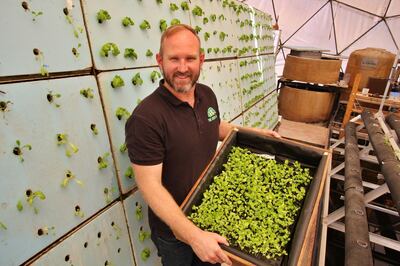
Similar farming technology can be found elsewhere in Jordan, such as on the roof of The Landmark Hotel in Amman, where a beige dome known as The Green Hub is home to an entire ecosystem. This is known as aquaponic farming and involves using fish to feed plants.
The idea behind The Green Hub, which launched in 2016, was to experiment with the process and demonstrate how rooftop space can be utilised while helping to conserve water. "Waste from the fish becomes the food for the plants, meaning that no fertiliser is needed," says The Green Hub managing director Kevin Schiltz.
He says the long-term goal of The Green Hub is to work with schools and offer workshops, while also providing people with simple kits they can use on their own. "We aim to actually inspire communities that could use some form of this technology, while highlighting the economic opportunities."
